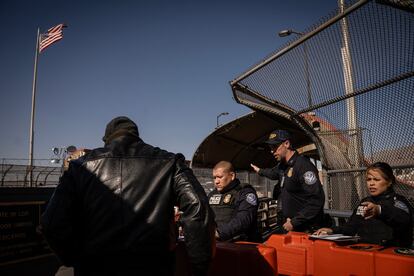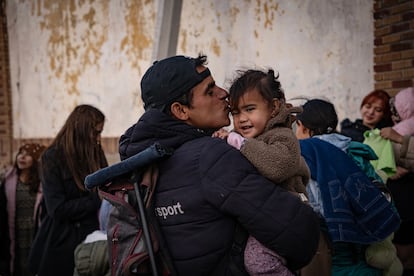Sol has an appointment in 10 days to meet his children, but Trump puts the reunion at risk

God is great and he knows, Sol thinks, covered with a borrowed coat, in sandals and socks, facing the cold wind of Ciudad Juárez. Only he knows why she and her two children, ages 10 and 16, waited for a year for an appointment to be accepted on the CBP One application to request asylum in the United States and it was never given to them. He will also know why when the boys surrendered to the border patrol, after losing their mother, only then did Sol receive the long-awaited confirmation message: his interview to request humanitarian permission would be on January 29, 2025, nine days later. of Donald Trump’s inauguration. First she cried with emotion and then a fierce fear came over her: “What do I do if Trump takes away the appointments? How do I find myself with my children?”
Sol is Venezuelan, a teacher, tall and blonde, she scolds the boys at the hostel for smoking as she did with her students and grabs the hot coffee that an organization distributes to take it to an older man who cannot stand to stand in line. “Wait for me here, I’ll be down now.” Sol is one of the thousands of migrants who have been waiting for months in Mexican territory for the United States Government to confirm their asylum appointment through CBP One, whose registration is free. It’s that or cross the border with a coyote. Since the system was installed in January 2023, more than one million migrants have preferred the legal route.
Trump promised from the campaign that he would remove the application and the call parole humanitarian: “Prepare to leave,” he said then. Now, a few hours after his inauguration, the threat is already a fear that is being chewed. It’s everywhere. It is said by pastors who manage migrant shelters, like Juan Fierro, from The Good Samaritan: “The one who is going to win from all this is going to be crime, that without a doubt”; researchers specialized in mobility, such as Rodolfo Rubio, from El Colegio de Chihuahua: “If CBP One disappears, they would have very few options. Those who are stranded here would have to return to their countries of origin — and many cannot — or become a market for traffickers,” and this is what migrants stretch in the days leading up to day zero.

Everyone shares the fear and uncertainty, because Angélica has been waiting in Juárez for 11 and a half months after leaving Michoacán; Gloria and her family, from Guatemala, have been there for 11 months; seven, Roxana Cuyun, from Chiapas; four, Irene and her four children, from Puebla; all fleeing violence, from organized crime, from the Government or from their partner, all clicking on the application every day so that hope is confirmed; all fearful of the future, but none like Sol, who is separated by a wall and the impulses of a president from his children.
The woman says that she took a while to leave Venezuela, she wanted to wait in case everything improved at some point. She was the director of a high school in Falcón, in the north of the country, and when she got divorced, she raised her three children. In addition to classes, she cleaned hotels, worked in a nursing home—because she had taken several nursing courses—and started a business. There came a time when he received 20 dollars a month from the Government of Nicolás Maduro and a lot of police harassment.
The first to emigrate was his eldest son, who went to Chicago (USA) after being persecuted by the Chavista regime. He hasn’t seen him for more than two years. On January 8, 2024, she and the two little ones left. The dream has always been the same: the four of them will meet again. “We crossed all the countries that everyone crosses, also the jungle,” he says quickly, that is not the important part of the story. On January 22 they settled in Mexico City, where he got a night shift at a printing press. They continued with that until early December, when several groups of Venezuelans decided to go north to surrender to the United States. The 18th was Migrant Day, that and the misinformation they thought would help them.

“The cold on the train… that can’t be compared with anything, with anything,” he says about the trip on La Bestia, “that’s what my children endured.” That journey was followed by hours of walking, encounters with the police and the National Guard, pleas and fear. They arrived in Juárez, ready to cross. They tried it with a group of families; they crouched at night fleeing from the vans they were guarding (“is it immigration or the cartel? Which is worse? Because the cartel can kill you, but immigration will send you back”); They crossed the river and arrived at the American trail soaked, at below zero. “Look at the misinformation we had, that they told us ‘buy gloves, buy balaclavas, for the cold.’ We left wrapped up in everything and all of that got wet when we crossed the river. Then it was time to undress the children, half cover them with a blanket. The temperature is so low that when wet it can give you hypothermia,” he says.
They were already about three meters from the hole in the border fence, when a girl in front got caught in the wire and started screaming. The United States patrol arrived and made them walk 12 hours, promising that they would receive them. “There was no path, it was pure weeds, and the dirty mud of the river, it was like the jungle again. I lost my shoes, I did some stitches barefoot, with my feet cut off.” They never managed to surrender to the other side. When they arrived at the shelter, almost a day later, the children had a fever and other migrants had already distributed the things they had left.
“At that point, we didn’t have any more money,” Sol admits. They couldn’t get the 100 pesos a day that the shelter cost per person or anything to eat. On January 10, a morning when they lost their mother, the children ended up turning themselves in scared to the border patrol. The teacher fell into deep sadness: “With everything we’ve been through, separating now… Am I a bad mother?” she still asks now. Three days after her children left, an email from CBP One notified her that her registration had been approved: “But I’m alone, they are already there,” she sobs, “it’s for the 29th, after Trump arrives.” , the next week, what if he cancels the appointment, how do I get through? You understand me? How do I pass? I read, I look for news, I go on TikTok, I go on Facebook…”, and no one has answers.
The minors are now in a center in Brownsville, Texas, near Monterrey, 12 hours from Juárez. “If I pass by, I go to where they are, to look for them, and if they return them, I go back to wherever they take them,” he says firmly. “You are in your country and the economic situation forces you to separate families, and you emigrate and it also separates families,” he sniffs his tears, “now we are in uncertainty, but I hope those people’s hearts can be touched. That they give a grace period, an extension, that the appointments that are already approved let the process continue and that those that are not, put at least another option. The union of many families depends on it.”






